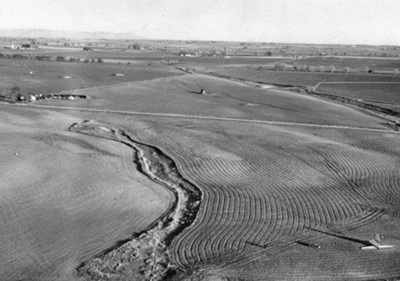In November of 1955, a horrific tragedy took place in the skies above Colorado, ultimately claiming the lives of 44 people and resulting in a law that made the bombing of commercial planes illegal.
On November 1, United Airlines Flight 629 took off from Denver and was headed to Portland – it wouldn't make it far. Only 11 minutes into the flight, the plane came crashing to the ground, killing everyone on board – 39 passengers and five crew members.
According to the FBI, wreckage that was recovered showed evidence of an explosion that had damaged the fuselage, with eyewitnesses claiming to have seen an explosion in the air and another on the ground.
A week into the investigation into the crash, it was determined that the crash was not the result of an accident or malfunction, with a request made for the FBI to open a criminal investigation.
As the investigation continued, a passenger named Daisie E. King was discovered to have been carrying newspaper clippings related to her son's legal troubles in her carry-on. Oddly enough, none of King's other luggage was found, with the exception of a few bits and pieces, according to the FBI.
This led investigators to take a look at her son, Jack Gilbert Graham, who had legal troubles related to forgery in the past, among other things, and was on a local 'most wanted' list. It's also worth noting that Graham was the beneficiary for at least $37,500 worth of life insurance policies on his mother, with acquaintances also having noted cases of friction between the two in the past.
As the investigation into Graham continued, FBI agents found wire associated with detonation devices at Graham's home.
This prompted further questioning of Graham and during subsequent interrogations, Graham folded, revealing to investigators the details of the horrible crime he had committed.
Graham had built a homemade bomb with 25 sticks of dynamite, stowing it in his mother's luggage and setting it to explode after a certain amount of time had elapsed – he had purchased a 60-minute 'off-type' timing device days before the crash. The explosion went off as planned, bringing the entire plane down over Longmont.
According to the FBI, King and Graham argued frequently, with Graham also set to get a large inheritance upon her death, in addition to a potential payout from life insurance policies.
Graham was charged with the premeditated murder of his mother, and initially, he attempted an insanity plea. This plan fell apart when he was found legally sane. After a 15-day trial in 1956, he was found guilty and ultimately sentenced to death. He was executed in January of the following year.
One question that often gets asked about the case is why Graham was only charged for one murder when 44 people had been killed. Ultimately, this has been called the easiest and quickest route for a death penalty conviction in the case, as laws about the destruction of a commercial airliner had yet to be written.
According to Denver Library, Graham's bombing of the plane known as Mainliner Denver sparked a wave of insurance-motivated airline bombings. None were quite as deadly as Graham's, but by July 1957, the US Congress would pass an act making the bombing of planes and buses a federal crime as a result.
The law related to bombing means of public transportation wasn't the only impact that Graham's case had. The case has since been called one of the most amplified trials of its time, mostly because it was the first trial in U.S. history where television cameras were allowed to record proceedings. People in the courtroom were able to opt out of being recorded, but among more than 80 witnesses and others involved, Graham was the only one to do so. The presence of cameras in the courtroom stuck around though, with this being a routine fixture from that point to the modern day.
If you're curious to read about this case more in-depth, check out the Denver Library coverage of the case or the FBI reporting.







(0) comments
Welcome to the discussion.
Log In
Keep it Clean. Please avoid obscene, vulgar, lewd, racist or sexually-oriented language.
PLEASE TURN OFF YOUR CAPS LOCK.
Don't Threaten. Threats of harming another person will not be tolerated.
Be Truthful. Don't knowingly lie about anyone or anything.
Be Nice. No racism, sexism or any sort of -ism that is degrading to another person.
Be Proactive. Use the 'Report' link on each comment to let us know of abusive posts.
Share with Us. We'd love to hear eyewitness accounts, the history behind an article.